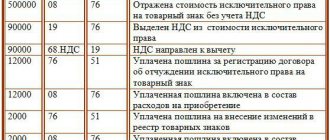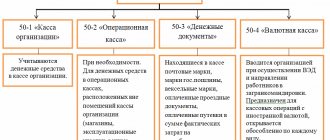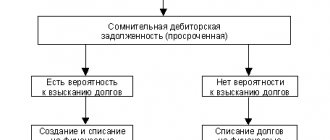Accounting entries
The receipt of materials into the organization is carried out under supply contracts, by manufacturing materials by the organization, making a contribution to the authorized (share) capital of the organization, receiving the organization free of charge (including a gift agreement). Materials include raw materials, basic and auxiliary materials, purchased semi-finished products and components, fuel, containers, spare parts, construction and other materials.
The following are accounting entries reflecting the receipt of materials into the organization.
- Accounting for receipt of materials under a supply agreement. Accounting entries
- Accounting for receipt of materials based on advance reports. Accounting entries
- Accounting for the receipt of materials under an exchange agreement. Accounting entries
- Accounting for receipt of materials under constituent agreements. Accounting entries
- Accounting for free receipt of materials. Accounting entries
- Accounting for the receipt of materials produced in-house
List of accounts involved in accounting entries:
|
|
| Account Dt | Kt account | Wiring Description | Transaction amount | A document base |
| Postings reflecting the accounting for the supply of materials with payment to the supplier after receipt of the materials | ||||
| 10 | 60.01 | The receipt of materials from the supplier to the organization's warehouse is reflected. Subaccount 10 is determined by the type of materials received | Cost of materials excluding VAT | Consignment note (form No. TORG-12) Receipt order (TMF No. M-4) |
| 19.3 | 60.01 | The amount of VAT related to the materials received is reflected. | VAT amount | Consignment note (form No. TORG-12) Invoice |
| 68.2 | 19.3 | The VAT amount applies to reimbursement from the budget. Posting is done if there is a supplier invoice | VAT amount | Invoice Purchase book Consignment note (form No. TORG-12) |
| 60.01 | 51 | The fact of repayment of accounts payable to the supplier for previously received materials is reflected. | Purchase price of goods | Bank statementPayment order |
| Postings for accounting for the supply of materials on prepayment | ||||
| 60.02 | 51 | Prepayment to the supplier for materials is reflected | Advance payment amount | Bank statementPayment order |
| 10 | 60.01 | The receipt of materials from the supplier to the organization's warehouse is reflected. Subaccount 10 is determined by the type of materials received | Cost of materials excluding VAT | Consignment note (form No. TORG-12) Receipt order (TMF No. M-4) |
| 19.3 | 60.01 | The amount of VAT related to the materials received is reflected. | VAT amount | Consignment note (form No. TORG-12) Invoice |
| 68.2 | 19.3 | The VAT amount applies to reimbursement from the budget. Posting is done if there is a supplier invoice | VAT amount | Invoice Purchase book Consignment note (form No. TORG-12) |
| 60.01 | 60.02 | The previously transferred prepayment is offset against the debt for the materials received. | Purchase cost of materials | Accounting certificate-calculation |
Capitalization of goods: documents, postings - Kontur.Accounting
To organize efficient production, it is important to maintain competent warehouse records. Knowing the documents used to register goods in the warehouse will help you protect your rights and keep records correctly. Correctly executed documentary support will protect against problems with the received goods and facilitate communication with the tax authorities.
Documents for registration of goods receipt
The posting of goods includes the reception and initial accounting of receipts. The goods can be accepted by a financially responsible person or a person by proxy. The receipt of goods is accompanied by the execution of primary documents by the supplier. These include:
- packing list;
- waybill (Bill of Lading) – it is needed to take into account the movements of goods and materials and pay for road transport;
- invoice.
An invoice is issued if the supplier pays VAT. An invoice allows you to offset VAT on the goods received for reimbursement. Organizations and entrepreneurs operating under the simplified taxation system do not pay value added tax and may not issue an invoice, and if the document is issued by the supplier on OSNO, they may not accept input VAT for reimbursement.
Before accepting the goods, check the correctness of the invoice: it must contain the details of the buyer and supplier, name of the product, quantity, price, cost, VAT.
To post the goods after acceptance, the invoice is stamped and signed by the responsible persons. The invoice is drawn up in two copies: one remains with the buyer, and the other is given to the seller. For the buyer, the invoice is a receipt document, and for the seller it is an expense document.
Universal transfer document (UDD)
This document is both a waybill and an invoice. Legislatively introduced in 2013 and not mandatory for use. You can decide for yourself whether you want to draw up two documents or just the UPD. Like an invoice, UTD provides the basis for obtaining a tax deduction.
The use of a universal document simplifies the process of transfer and acceptance of inventory items. Use it to formalize the supply of goods, works or services and the transfer of property rights. The UPD is signed by the authorized person responsible for the preparation of primary documents or purchase and sale transactions.
In the legally established form of the UPD there is a status field. It determines which document you are submitting the UPD instead of:
- Invoice and delivery note;
- Packing list;
- Invoice (for electronic form).
The status of the document changes the order in which it is filled out: for status 2, you do not need to fill out some lines, the UPD number and the required signatures change. To use the UPD in an organization, its form must be approved. The official form is advisory in nature, and the organization may make changes to it. But all mandatory details of the primary documents must comply with the requirements.
Acceptance of goods
At the first stage of acceptance of goods, we check whether the type and quantity of goods corresponds to the information in the accompanying documents. This is necessary to ensure completeness of accounting. The second stage is acceptance of the goods for quality and completeness.
Acceptance of goods is carried out by the financially responsible person in the presence of a representative of the supplier, unless other conditions are specified in the contract.
If all the goods are in place and no defects are found, confirm compliance with the organization’s stamp and signature.
Based on the results of acceptance of the goods, a TORG-1 act and a TORG-11 product label are drawn up. Product label data is needed to conduct an inventory list.
Violation of the inspection deadlines and acceptance rules will deprive you of the right to file a claim against the supplier or carrier. For certain types of goods, the terms are established by law, for others they are specified in the contract. Registration of the return of low-quality goods depends on the moment of detection of the defect:
- if a shortage of goods or defects is detected during acceptance, the commission draws up a report on the discrepancy in quantity and quality; the act is drawn up in the TORG-2 form; if properly executed, it will serve as the basis for making claims;
- when a defect is discovered after the goods are registered, an invoice is drawn up indicating the quantity of the goods being returned, a statement of identified defects, a letter of claim and a return invoice;
- if one of the types of goods was not delivered to you, cross them out from the invoice and adjust the invoice.
At the end of acceptance, capitalize the received goods and materials according to the actual quantity and amount.
What to do if there are no accompanying documents
For accounting, the main thing is documents. If there is no document, there is no accounting object. When a supply agreement is available, but the supplier has not provided accompanying documents, the goods received must also be capitalized.
For such cases, a TORG-4 acceptance certificate is provided. In the absence of a delivery note and an invoice, it is difficult to determine the price at which the goods arrive. The price must be taken from the contract, and if there is no contract, then the goods are purchased at the market price. The TORG-4 act contains information about the actual availability of the received goods.
The acceptance certificate is drawn up by a special commission that accepts the goods. TORG-4 is drawn up in two copies, one is transferred to the financially responsible person of the supplier, and the other to the accounting department.
Receipt of goods - postings
In accounting, the recording of the acquisition of goods varies and depends on the method of transfer of ownership.
Payment deferment. Ownership passes when the goods are transferred to the buyer. Include the costs of delivery and procurement costs in the actual cost of goods received.
Debit Credit
| Goods received (without VAT) | 41 | 60 |
| VAT charged | 19 | 60 |
| Shipping costs | 41 | 60 |
| VAT charged on delivery | 19 | 60 |
| VAT is accepted for deduction | 68 | 19 |
| Debt repaid | 60 | 50(51) |
Prepayment. The contract states that ownership of the goods passes after payment.
Debit Credit
| Payment transferred to the supplier | 60 | 50 (51) |
| Goods received (without VAT) | 41 | 60 |
| VAT charged | 19 | 60 |
| VAT deductible | 68 | 19 |
As part of the receipt of goods, it is worth noting situations related to the return of goods to the supplier. Depending on whether the goods were accepted for accounting and whether they were paid for, the postings change.
- If a defect is discovered during acceptance of the goods, the goods have not yet been accepted for accounting and have not been paid for, in this case the goods are recorded on off-balance sheet account 002. Return of goods to the supplier should be reflected on the credit of this account.
- If a defect is discovered after registration and payment, record the return of goods to the supplier and write off VAT if it has not yet been deducted. If VAT has already been refunded, then restore it.
Debit Credit
| The defect was returned to the supplier | 76 | 41 |
| VAT restored | 76 | 68 |
| or VAT written off | 76 | 19 |
| Money returned for goods of poor quality | 51 | 76 |
Elizaveta Kobrina
https://youtu.be/wYz00Cxgrvk
Keeping records of goods receipts will become easier using automated programs. The cloud service Kontur.Accounting allows you to store all information about goods in one place and simplifies the procedure for posting goods. Enter invoices, invoices, and bill payment information. Keep records of receipts and disposals of inventory items.
Let us examine in detail what an interested party transaction is, who the controlling persons are, how to formalize such a transaction and, if something happens, challenge it.
, Mikhail Kobrin
In accounting and tax accounting, income and expenses can be recognized in two ways. The first one is the accrual method. The second option is the cash method.
In practice, most often companies keep records using the first method, following the instructions of accounting standards and the Tax Code. It is believed that the recognition of income and expenses upon shipment most accurately reflects the results of the business.
However, sometimes businesses may or may even be required to account for expenses upon payment.
OSNO is the busiest tax regime for a company. The organization must pay three mandatory taxes and submit reports on time. The set of documents is significant; reports must be submitted to the tax office, funds and Rosstat. In this article we will talk about the main rules for submitting reports, deadlines and nuances.
, Elizaveta Kobrina
Source: https://www.B-Kontur.ru/enquiry/427-dokumenty-dlya-oprihodovaniya-tovara
Accounting for receipt of materials based on advance reports. Accounting entries
Below are accounting entries reflecting the accounting of receipt of materials from accountable persons on the basis of advance reports and the primary documents attached to them (delivery notes, invoices).
The receipt of materials from an accountable person can be reflected in two options:
- In the first option, a standard posting scheme is considered, reflecting the receipt of materials from account 71 “Settlements with accountable persons”. The disadvantage of this option is that the accounting does not reflect the supplier from whom the materials were received and for which VAT was refunded.
- In the second option, the receipt of materials is reflected in correspondence with account 60 “Settlements with suppliers and contractors” and further, the debt to the supplier is closed in correspondence with account 71 “Settlements with accountable persons”. With this reflection option, there is an additional opportunity to analyze supplies by supplier
| Account Dt | Kt account | Wiring Description | Transaction amount | A document base |
| A variant of accounting entries reflecting the receipt of materials from accountable persons according to the standard scheme | ||||
| 71 | 50.01 | The issuance of funds from the organization's cash desk to an accountable person is reflected. | Amount issued for reporting | Account cash warrant. Form No. KO-2 |
| 10 | 71 | The receipt of materials from the accountable person to the organization's warehouse is reflected on the basis of primary documents attached to the advance report. Subaccount 10 is determined by the type of materials received | Cost of materials excluding VAT | Consignment note (form No. TORG-12) Receipt order (TMF No. M-4) Advance report |
| 19.3 | 71 | The amount of VAT related to the materials received is reflected. | VAT amount | Consignment note (form No. TORG-12) Invoice |
| 68.2 | 19.3 | The VAT amount applies to reimbursement from the budget. Posting is done if there is a supplier invoice | VAT amount | Invoice Purchase book Consignment note (form No. TORG-12) |
| A variant of accounting entries reflecting the receipt of materials from accountable persons according to a scheme using a accounts payable account | ||||
| 71 | 50.01 | The issuance of funds from the organization's cash desk to an accountable person is reflected. | Amount issued for reporting | Account cash warrant. Form No. KO-2 |
| 10 | 60.01 | The receipt of materials from the supplier to the organization's warehouse is reflected on the basis of primary documents attached to the expense report. Subaccount 10 is determined by the type of materials received | Cost of materials excluding VAT | Consignment note (form No. TORG-12) Receipt order (TMF No. M-4) |
| 19.3 | 60.01 | The amount of VAT related to the materials received is reflected. | VAT amount | Consignment note (form No. TORG-12) Invoice |
| 68.2 | 19.3 | The VAT amount applies to reimbursement from the budget. Posting is done if there is a supplier invoice | VAT amount | Invoice Purchase book Consignment note (form No. TORG-12) |
| 60.01 | 71 | Reflects payment to the supplier by the accountable person for materials received | Purchase cost of materials | Accounting certificate-calculationAdvance report |
Receipt of goods and services 1C: Accounting 3.0
The main business operations of an organization are the purchase of goods or services from suppliers. The document Receipts of goods and services (Receipts (acts, invoices))
is one of the most basic in the program; this document formalizes the receipt of goods for subsequent resale, services provided to our company, the receipt of fixed assets or materials for production. The purchase of goods from a supplier in the program is reflected in 2 stages:
The purchase of goods from a supplier begins with payment for the goods (prepayment purchase).
Stage 1: Payment to the supplier The supplier issues an invoice for the goods, and based on this invoice we generate a payment order in 1C.
Go to Bank and cash desk - Payment orders and click the Create button.
Fill out the Payment Order. When using the DirectBank system, you can immediately upload this payment order to the client bank. Type of transaction: “Payment to supplier”, Date, Recipient (select the supplier of goods), enter the amount of payment on the invoice, Purpose of payment. When creating a payment purpose, you can use a dictionary of synonyms that will help you easily operate in Russian! In the “Status” field, select Paid and follow the link “Enter a debit document from the current account.”
The document “Write-off from the current account” appears where all fields are filled in automatically from the base document (from the payment order). We check the correctness of the entered data. Uncheck the "Verified by Bank Statement" checkbox because the funds have not yet been debited by the bank. When saving the “Write-off from the current account” document, no transactions are generated.
Let's return to the Payment order document. To see a printed form of the document, click the “Payment order” button. Swipe and close
After you have received a bank statement showing the debiting of funds for the goods, you must confirm the previously created document “Debit from the current account” to generate transactions. section Bank - Bank statements - Debit from current account and check the box “Confirmed by bank statement. Conduct.
Accounting for the receipt of materials under an exchange agreement. Accounting entries
The legal basis that determines the procedure for forming an exchange agreement is defined in Chapter 31 “Barter” of the Civil Code of the Russian Federation. The methodology for reflecting supply transactions under an exchange agreement is discussed in more detail in the article “Accounting for the purchase and sale of goods under an exchange agreement”
The cost of materials to be transferred is established based on the price at which, in comparable circumstances, the organization determines the cost of similar materials.
Below are accounting entries reflecting the accounting for the receipt of materials from suppliers under an exchange agreement with the usual procedure for transferring ownership of materials, in accordance with Article 223 “Moment of the emergence of the acquirer’s right of ownership under the agreement” of the Civil Code of the Russian Federation and Article 224 “Transfer of a thing” of the Civil Code of the Russian Federation.
| Account Dt | Kt account | Wiring Description | Transaction amount | A document base |
| 10 | 60.01 | The receipt of materials from the supplier under an exchange agreement is reflected. Subaccount 10 is determined by the type of materials received | Market value of materials excluding VAT | Invoice (TMF No. M-15) Receipt order (TMF No. M-4) |
| 19.3 | 60.01 | The amount of VAT related to the materials received is reflected. | VAT amount | Invoice (TMF No. M-15) Invoice |
| 68.2 | 19.3 | The VAT amount applies to reimbursement from the budget. Posting is done if there is a supplier invoice | VAT amount | InvoicePurchase book |
| 62.01 | 91.1 | The transfer of exchanged materials to the supplier under the exchange agreement is reflected | Market value of transferred materials | Invoice (TMF No. M-15) Invoice |
| 91.2 | 10 | The write-off of transferred materials from the organization’s balance sheet is reflected. Subaccount of account 10 is determined by the type of materials transferred | Cost of materials | Invoice (TMF No. M-15) Invoice |
| 91.2 | 68.2 | The amount of VAT accrued on the transferred materials is reflected | VAT amount | Invoice (TMF No. M-15) Invoice Sales book |
| 60.01 | 62.01 | The debt of the second party under the exchange agreement is offset | Cost of materials | Accounting certificate-calculation |
Contract of sale
If materials are supplied for a fee, you will receive from the supplier or shipper:
- payment documents (bills, invoices, invoices, etc.);
- accompanying documents (specifications, certificates, quality certificates, etc.).
This is stated in paragraph 1 of paragraph 44 of the Methodological Instructions, approved by order of the Ministry of Finance of Russia dated December 28, 2001 No. 119n.
When you receive materials, check whether the data in the accompanying documents corresponds to those provided for by the terms of the contract (range, quantity, prices, method and terms of shipment, etc.). Also make sure that all amounts in the settlement documents are calculated correctly.
In this case, reflect the actual cost of materials in the amount:
- payment to the materials supplier;
- transportation and procurement costs;
- costs of bringing materials to a state in which they are suitable for use (including toll processing).
Such a list is established in paragraph 68 of the Methodological Instructions, approved by Order of the Ministry of Finance of Russia dated December 28, 2001 No. 119n.
Debit 10 Credit 60 (76)
– the receipt of materials is reflected at actual cost, taking into account transportation and procurement costs.
This follows from the provisions of paragraph 80 of the Methodological Instructions, approved by order of the Ministry of Finance of Russia dated December 28, 2001 No. 119n, and the Instructions for the chart of accounts (accounts 10, 60, 76).
An example of reflecting in accounting the receipt of materials under a purchase and sale (supply) agreement. The cost of materials is formed on account 10
LLC "Proizvodstvennaya" received the materials necessary for the production of products. The cost of materials was 118,000 rubles. (including VAT – 18,000 rubles). Delivery of materials cost 59,000 rubles. (including VAT – 9000 rubles). The materials have been entered into the warehouse. The organization accounts for materials on account 10 at actual cost (without using accounts 15 and 16).
Debit 10 Credit 60–150,000 rub. (118,000 rub. – 18,000 rub. 59,000 rub. – 9,000 rub.) – the receipt of materials is reflected, taking into account delivery costs;
Debit 19 Credit 60–27,000 rub. (RUB 18,000 RUB 9,000) – input VAT included;
Debit 68 subaccount “Calculations for VAT” Credit 19–27,000 rub. – VAT is accepted for deduction upon receipt of a correctly executed supplier invoice;
Debit 60 Credit 51– 177,000 rub. (118,000 rubles. 59,000 rubles) – paid for materials including delivery costs.
Debit 15 Credit 60 (76)
– the receipt of materials is reflected in the assessment provided for in the contract with the supplier or other documents;
– transport, procurement and other similar expenses are taken into account in the actual cost of materials;
Debit 10 Credit 15
– materials are capitalized at the accounting price.
Debit 16 Credit 15
– the excess of the actual cost of materials over their book price is reflected;
Debit 15 Credit 16
– the excess of the accounting price of materials over their actual cost is reflected.
This follows from the provisions of paragraph 80 of the Methodological Instructions, approved by Order of the Ministry of Finance of Russia dated December 28, 2001 No. 119n, and the Instructions for the chart of accounts (accounts 10, 15, 16, 60, 76).
An example of reflecting in accounting the receipt of materials under a purchase and sale (supply) agreement. Materials are capitalized at a book price that is less than their actual cost
Proizvodstvennaya LLC received 100 cans of paint at a price of 1,180 rubles. (including VAT - 180 rubles). Costs for delivery of materials amounted to 29,500 rubles, including VAT – 4,500 rubles. The materials have been entered into the warehouse. The accounting policy of the organization provides for the use of accounts 15 and 16. The accounting price of incoming paint is 1200 rubles.
The total cost of the received paint was 118,000 rubles. (RUB 1,180 × 100 pcs.), including VAT – RUB 18,000. (180 rub. × 100 pcs.).
Debit 15 Credit 60–100,000 rub. (118,000 rubles – 18,000 rubles) – the receipt of materials from the supplier is reflected;
Debit 15 Credit 60–25,000 rub. (RUB 29,500 – RUB 4,500) – the cost of delivery of materials from the supplier is taken into account.
The actual cost of the incoming paint included the costs of its delivery. Therefore, the actual cost of the entire batch of paint was: 100,000 rubles. 25,000 rub. = 125,000 rub.
Debit 19 Credit 60–22,500 rub. (18,000 rub. 4,500 rub.) – VAT on purchased materials is taken into account, taking into account delivery costs;
Debit 68 subaccount “Calculations for VAT” Credit 19–22,500 rub. – VAT is accepted for deduction upon receipt of a correctly executed supplier invoice;
Debit 10 Credit 15–120,000 rub. (RUB 1,200 × 100 pcs.) – materials were capitalized at the accounting price;
Debit 16 Credit 15–5000 rub. ((1250 rub. – 1200 rub.) × 100 pcs.) – a deviation is reflected due to the excess of the actual cost over the book price;
Debit 60 Credit 51– 147,500 rub. (29,500 rub. 118,000 rub.) – payment was made to the supplier for received materials and to the transport company for delivery of materials.
An example of reflecting in accounting the receipt of materials under a purchase and sale (supply) agreement. Materials are capitalized at a book price that is greater than the actual cost
Proizvodstvennaya LLC received 100 cans of paint at a price of 1,180 rubles. (including VAT - 180 rubles). Costs for delivery of materials amounted to 29,500 rubles, including VAT – 4,500 rubles. The materials have been entered into the warehouse. The organization's accounting policy provides for the use of accounts 15 and 16. The accounting price of incoming paint is 1,300 rubles.
Debit 10 Credit 15– 130,000 rub. (RUB 1,300 × 100 pcs.) – materials were capitalized at the accounting price;
Debit 15 Credit 16– 5000 rub. ((1300 rub. – 1250 rub.) × 100 pcs.) – a deviation is reflected due to the excess of the accounting price over the actual cost;
When you have received materials not as your property, but temporarily, reflect their receipt on the balance sheet in account 002 “Inventory assets accepted for safekeeping.” For example, you can reflect the receipt of reusable packaging that needs to be returned to the supplier.
Debit 002
– the receipt of materials for safekeeping is reflected.
Accounting for receipt of materials under constituent agreements. Accounting entries
According to the constituent agreement, the founders (participants) contribute various types of property, including materials, to the authorized (share) capital of the organization. According to clause 8 of PBU 5/01 “Accounting for inventories”, the actual cost of inventories (materials) contributed to the contribution to the authorized (share) capital of the organization is determined based on their monetary value, agreed upon by the founders (participants) of the organization .
Based on the above provisions, the receipt of materials under the constituent agreement can be reflected in the accounting below with the following entries.
| Account Dt | Kt account | Wiring Description | Transaction amount | A document base |
| 10 | 75.1 | We reflect the receipt of materials under the constituent agreement. Subaccount 10 is determined by the type of materials received | Estimated cost of materials agreed upon by the founders | Receipt order (TMF No. M-4) Certificate of acceptance of transfer of materials |
| 19 | 83 | If the founder transferring materials to the authorized capital of the organization, in accordance with clause 3 of Article 170 of the Tax Code of the Russian Federation, restores VAT, the receiving party must make this posting | The amount of VAT restored by the founder | InvoiceAct of acceptance of transfer of materials |
What nuances affect the reflection of goods and services in accounting?
In the business activities of any company, the need regularly or periodically arises to purchase goods and (or) services from third-party sellers (performers, suppliers). If material assets are purchased in a retail chain, from the seller’s point of view they are all goods. However, when posting a purchase to the company (buyer) accounts, it is necessary to correctly classify it as:
- goods for resale (account 41 “Goods”);
- fixed assets (accounts 08 “Investments in non-current assets”, 01 “Fixed assets”);
- MPZ (accounts 10 “Materials”, 15 “Procurement and acquisition of material assets”, 16 “Deviation in the cost of material assets”).
The situation with the purchase of services is also ambiguous. The determining factor here is the purpose of their acquisition. For example:
In each case, the transactions for the purchase of goods and services will be different.
What is a service and what types of services exist, find out from this material.
Accounting for free receipt of materials. Accounting entries
In accounting, according to clause 16 of PBU 9/99 “Income of the organization,” income in the form of gratuitous receipt of property is recognized “as it is generated (identified).”
In tax accounting, according to paragraphs. 1 clause 4 of Article 271 “Procedure for recognizing income under the accrual method” of the Tax Code of the Russian Federation, income in the form of gratuitous receipt of property is recognized on the date the parties sign the property acceptance and transfer act.
According to clause 9 of PBU 5/01 “Accounting for inventories”, “the actual cost of inventories received by an organization under a gift agreement or free of charge ... is determined based on their current market value as of the date of acceptance for accounting.”
Based on the above provisions, the gratuitous receipt of materials can be reflected in the accounting below using the following entries.
| Account Dt | Kt account | Wiring Description | Transaction amount | A document base |
| 10 | 91.1 | We reflect the free receipt of materials. Subaccount 10 is determined by the type of materials received | Market value of materials on the date of acceptance for accounting | Receipt order (TMF No. M-4) Certificate of acceptance of transfer of materials |
Postings upon receipt of goods from the supplier
The assessment of inventories, the cost of which upon acquisition is determined in foreign currency, is made in rubles by recalculating the amount in foreign currency at the rate of the Central Bank of the Russian Federation effective on the date of acceptance of inventories for accounting
.
PBU 5/01
12. The actual cost of inventories, in which they are accepted for accounting, is not subject to change
, except in cases established by the legislation of the Russian Federation.
PBU 3/2000
2. This Regulation does not apply: ...
when recalculating the value of assets and liabilities expressed in foreign currency or in conventional monetary units, but payable in rubles
; …
For many organizations, the main source of income is the sale of goods and (or) services. Sales are reflected in accounting at the time of shipment or at the time of payment. Each type of reflection has its own postings for the sale of goods and (or) services.
The most common types of sales of goods and services are:
- Sales of goods and services – posting to wholesalers;
- Sale of goods and services – retail postings.
Let's take a closer look at each type of implementation.
Sales in wholesale trade
An organization that is a supplier enters into an agreement for the sale of goods (services) with a counterparty who is a buyer. Sales transactions depend on the method of transfer of ownership of shipped goods:
- The organization recognizes ownership rights at the time of sale of goods (services), regardless of the terms of payment;
- The organization recognizes ownership rights only after payment for the goods (services) sold.
Accompanying documents for the sale of goods (services):
- Issue a consignment note TORG-12;
- Invoice issued (clause 3 of article 168 of the Tax Code of the Russian Federation).
Retail sales
The organization carries out direct sales of goods (services) to consumers through cash payments, bank cards or settlement checks. To record the volume of revenue, a cash register (CCM) is used.
Accounting for the sale of goods in retail trade is carried out in the following ways:
Accounting for the receipt of materials produced in-house
According to the methodological instructions, materials are accepted for accounting at actual cost. The actual cost of materials when manufactured by the organization is determined based on the actual costs associated with the production of these materials. Accounting and formation of costs for the production of materials are carried out by the organization in the manner established for determining the cost of relevant types of products. Those. The procedure for reflecting materials produced in-house in accounting depends on the methodology for calculating the cost of products used in the organization.
Currently, the following types of assessment of finished products are used:
- At actual production cost. This method of assessing finished products (manufactured materials) is used relatively rarely, as a rule, in single and small-scale production, as well as in the production of mass products of a small range.
- Based on the incomplete (reduced) production cost of products (manufactured materials), calculated based on actual costs without general business expenses. Can be used in the same industries where the first method of product evaluation is used.
- At standard (planned) cost. It is advisable to use in industries with mass and serial production and a large range of products.
- For other types of prices.
Below we will consider two options for recording the receipt of materials produced in-house in accounting.
| Account Dt | Kt account | Wiring Description | Transaction amount | A document base |
| Accounting for materials at standard (planned) cost. | ||||
| 10 | 40 | The release (manufacturing) of materials is reflected at the planned cost | Planned cost | Receipt order (TMF No. M-4) |
| 40 | 20 | The actual production cost is reflected | Actual cost of manufactured materials | Accounting certificate-calculation |
| 10 | 40 | The write-off of deviations between the cost of materials at actual cost and their cost at standard (planned) cost is reflected. | The amount of deviation is “black” or “red” depending on the balance of the deviation | Accounting certificate-calculation |
| Accounting for materials at actual cost. | ||||
| 10 | 20 | The release (manufacturing) of materials is reflected at actual cost | Actual production cost | Receipt order (TMF No. M-4) |
Postings for the sale of goods and services using examples
Example 1. Settlements with customers
Vesna LLC entered into an agreement for the sale of goods with the counterparty (buyer) for a total amount of 53,100 rubles, incl. VAT 8,100 rub. Payment for sold goods will be made after shipment to the buyer.
In the accounting records of Vesna LLC, the accountant created the following entries for settlements with customers:
Get 267 video lessons on 1C for free:
Example 2. Sale of goods: retail transactions
Vesna LLC purchased goods in the amount of 50 pieces. for a total amount of 76,700 rubles, incl. VAT 11,700 rub. The product was purchased for retail sale. The goods are transferred to the Store at sales prices. In accordance with the accounting policy, account 43 “Trade margin” is used to record the sales price. The selling price is formed at 1,820.00 per piece and the trade margin is determined.
In the accounting records of Vesna LLC, the following entries were generated for the sale of goods:
| Debit Account | Credit Account | Transaction amount, rub. | Wiring Description | A document base |
| 41.11 | 41.01 | 91 000 | Moving goods from warehouse to store (65,000 + 26,000) | Invoice for internal movement (TORG-13) |
| 41.11 | 42.01 | 26 000 | Trade margin taken into account (1,820 * 50 - 65,000) | |
| 50.01 | 90.01.1 | 107 300 | Retail revenue taken into account (65,000 + 26,000 + 16,380) | Receipt cash order (KO-1), Cash register control tape, Cashier-operator's journal (KM-4), Cashier-operator's certificate report (KM-6) |
| 90.03 | 68.02 | 16 380 | VAT charged on retail revenue (91,000 * 18%) | |
| 90.02.1 | 41.11 | 91 000 | Write-off of goods at retail price | |
| 90.02.1 | 42.01 | — 26 000 | Write-off of trade margins on goods sold | Help for calculating the write-off of trade margins on goods sold |
Example 3. Sales of services: postings with cost control
Trans-Service LLC provides transport services. In March 2016, transport services were provided for a total amount of RUB 118,000, incl. VAT 18% - 18,000 rub. To determine the profitability of transport services, the company keeps records of the cost of each transport service. According to the accounting policy, costs for transport services are written off at the planned cost on the day the service is provided.
Calculation of the cost of transport services for the month of March:
- Salary of car drivers – 43,000 rubles;
- Accrued depreciation for the month of March – 15,450 rubles;
- The cost of written-off spare parts for car repairs is RUB 2,500;
- The cost of the transport service is 60,950 rubles.
In the accounting records of Trans-Service LLC, entries are made for the service provided:
| Debit Account | Credit Account | Transaction amount, rub. | Wiring Description | A document base |
| 62.01 | 90.01.1 | 118 000 | The cost of the transport service provided is taken into account | Certificate of provision of services, Invoice issued |
| 90.02.1 | 20.01 | 60 950 | The planned cost of transport services has been written off | |
| 90.03 | 68.02 | 18 000 | VAT is charged on the transport service provided | |
| 20.01 | 70 | 43 000 | Amount of accrued wages | Time sheet and calculation of wages (T-12), Payroll (T-51) |
| 70 | 68.01 | 5 590 | Amount of accrued personal income tax (43,000*13%) | |
| 20.01 | 69 | 12 986 | Amount of accrued insurance premiums (43,000 * 30.2) | |
| 20.01 | 02.01 | 15 450 | Amount of accrued depreciation for the month of March | Help - calculation of depreciation of fixed assets |
| 20.01 | 10.05 | 2 500 | The cost of spare parts for car repairs has been written off | Requirement-invoice for release of materials according to form (M-11) |
| 90.02.1 | 20.01 | 12 986 | Adjustment of the cost of writing off the service provided to close actual expenses | Help-calculation of product costs; Help calculating the cost of manufactured products and rendered production services |
Receipt of goods - accounting entries will depend on how the company plans to use the acquired value (resell, use in the manufacture of products, etc.) and other nuances. Which accounting accounts are involved in recording transactions for the receipt of goods and services, when the goods can only be accounted for on the balance sheet? Find answers to these and other related questions in our material.









